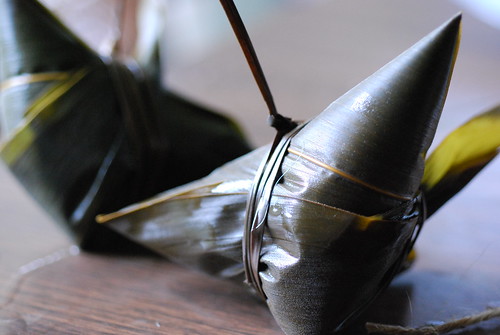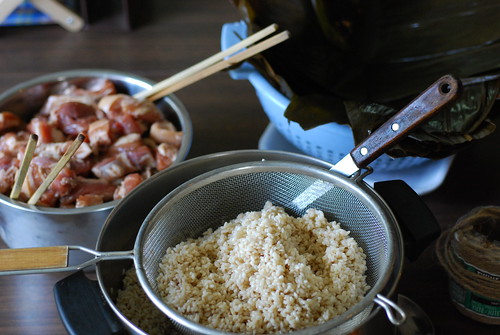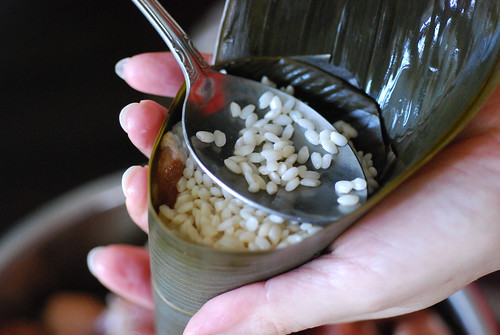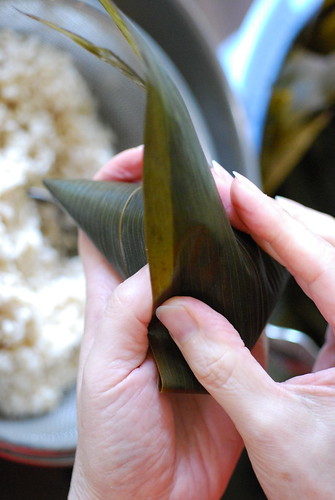
I don't think anyone would be surprised to know that my favorite festivals are the ones that revolve around food. Fortunately, most of the Chinese ones seem to involve food in some capacity!
Anyway, it is just a few days to Duan Wu Jie (the fifth day of the fifth month on the lunar calendar; this year, that's May 28th) and what better time to share the zongzi, THE traditional food for this holiday. Zongzi is the Mandarin term, by the way. I can't remember quite when my mom first taught me how to fold them, but it's been...hm...well, a pretty long time ago. It's kind of a time consuming process and as I understand it, a lot of families no longer make their own, opting instead for the ones offered in groceries or by restaurants. Which is all well and good, but I only like the ones WE make. More importantly though, I think of this as kind of a family tradition, one in which technique and skills are passed down (along with a liberal helping of taunting my mother). And with that in mind, I strongly encourage you to try making these; as I said, they do take a bit of time and preparation (and sourcing of ingredients) but I think you will find it extremely rewarding.
(You can read a bit about the back story of zongzi at Wikipedia.)

So honestly, I think the majority of the work is in the preparatory stage. Which, I am very ashamed to say, my mother handled all of. But here are the main ingredients you need (and hopefully mom will pipe up and tell me if I missed anything). I can't give quantities because that depends greatly on how many you are planning to make, but my principle is THE MORE PORK THE BETTER!!:
Pork belly, cut into chunks and marinated in pork broth and soy sauce
Glutinous rice, soaked in water and soy sauce
Bamboo leaves, which you purchase dry and then boil until softened. After that, you have to scrub them clean and then snip off the sharp ends.
You should also have some kitchen string to tie them up; our packet of bamboo leaves came with bamboo "string" but any old kitchen twine will do.

When you are ready, drain your rice in a sieve. To form the dumplings, take two bamboo leaves, one on top of the other (with the veined side down). Your aim is to fold them in such a way as to form a cone, with the midpoint of the leaves as the bottom point. You should then be holding the cone in one hand with the open top facing you as you see in the photo above. Put a spoonful or two of rice into the cone; you want it to be just under halfway full.

Add a chunk or two of the marinated pork, and then top with rice, basically up to the edge. Other variations of the zongzi include salted egg yolks, beans, mushrooms, and so on, so feel free to experiment.

You want to pat the rice down to compact it a bit, but don't pack it down too much as you need to leave a little room for it to expand. (Doesn't my mom have nice hands?)

Okay, now the slightly tricky bit. Fold the loose ends down towards the hand holding the cone; at the same time, you want to use the cone fingers to push the top sides of the leaves in a little. Continue to fold the loose leaf ends to the right of the cone. The goal of course, is to enclose the entire open surface with the loose leaf ends. I guarantee that the first few times you try to do this that you will have rice escaping; don't worry. It'll come to you. It helps to underfill the cone a little at first.

You now have in your hand a folded dumpling with some excess leaves sticking out of one side. Don't lose your grip! You now need to tie the dumpling shut with your kitchen twine; I recommend that you hold one end in your teeth and with your free hand, wrap the dumpling around the middle (see the next photo). You want it fairly tight so the leaves don't unwrap themselves. Snip off the excess string and congratulations! You have a zongzi!

You can see in this photo where the string should go (the zongzi is upside down here). You can trim off the excess leaves if you want, but I personally think they kind of look nicer this way. All you need to do now is cook! We make enough to fill a giant stockpot and boil it for several hours (almost overnight). I don't think you can reeeaaally overcook these. Once they are done, drain them, wash them, and let them dry. Then you can store them (we keep some in the freezer) or eat them immediately!

I hope you have enjoyed this (very long-winded) tutorial on how to make your own delicious zongzi, and I hope that some of you will try making these and maybe add a new tradition to your family!
5 comments:
Those are so cute! I love getting them at dim sum restaurants, but I've never thought of trying it myself.
Now I know how!
I have been wanting to learn how to make this! I am hoping to get a lesson from my aunt, but thanks for the tutorial in the meantime!!
Sweet Bird thanks! I keep teasing my mother and telling her mine look nicer than hers now, but I know she's really the master :) Please let me know if you try making your own!
Hi Laura! I think the great thing about any kind of family food tradition is seeing how everyone's is slightly different. Hope you share your aunt's version when you learn :)
Wow! Great photos! I've been hesitant about trying a recipe for these...but was always stuck at the wrapping part. Thanks for the great pictures! Another thing...is there a way to test their 'done'ness? In another recipe - it just says to "boil until cooked". What's "cooked"??!
Keep up the great work!
@the spoon: Thanks! :) I realized I had to have photos because trying to describe the wrapping process only in words was almost impossible! Fortunately my mother is very patient :)
As far as doneness, we tend to make these in huge batches (like in restaurant sized stockpots) and we just let it simmer for at least 5 hours. I know we've let it go overnight in some cases and the dumplings have been fine. If you are making a small batch, I would say 3-4 hours at a simmer would be enough. When you squeeze them after cooking, they should be yielding and you shouldn't feel any grains (squeeze them before cooking to see what I mean by that). Hope that helps :)
Post a Comment